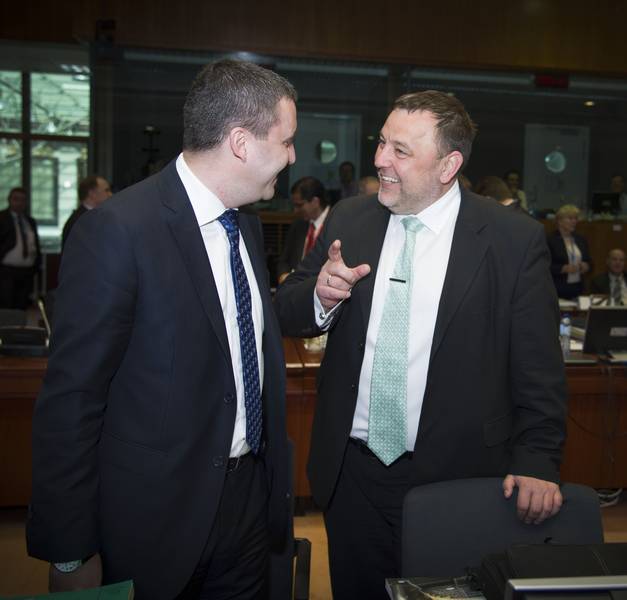ECOFIN will discuss the new financial architecture in Europe
Adelina Marini, June 9, 2009
 The new supervisory system on banking, insurance and securities markets will be discussed at ECOFIN today. The Communication which the Commission formulated officially almost 2 weeks ago, is based upon the de Larosiere report, presented in February, which requires stricter control over the banking sector and, in fact, the establishment of new financial architecture? The Commission Communication should be discussed by all interested parties until 15th of July and then it should be approved. Today the finance ministers of the EU will for the first time discuss it. The first decisions are expected to be taken by the European Council on the 18th and 19th of June in Brussels.
The new supervisory system on banking, insurance and securities markets will be discussed at ECOFIN today. The Communication which the Commission formulated officially almost 2 weeks ago, is based upon the de Larosiere report, presented in February, which requires stricter control over the banking sector and, in fact, the establishment of new financial architecture? The Commission Communication should be discussed by all interested parties until 15th of July and then it should be approved. Today the finance ministers of the EU will for the first time discuss it. The first decisions are expected to be taken by the European Council on the 18th and 19th of June in Brussels.
The idea of a new financial architecture in the EU is based on 2 pillars: establishment of a European Systemic Risk Council (ESRC) and a European System of Financial Supervisors (ESFS).
What is the ESRC? According to the European Commission, the weaknesses of the present arrangements for macro-prudential supervision have had dramatic consequences across the global financial system. Many of the imbalances that accumulated in the global financial system before the crisis can be attributed to excessive credit expansion and surging asset price inflation, amid a generalised under-pricing of financial risk in a period of sustained non-inflationary economic growth. That is why the G20 has decided to reinforce the global arrangements for safeguarding
financial stability at the global level, with the newly established Financial Stability Board
(FSB) expected to collaborate closely with the International Monetary Fund (IMF) to provide
early warnings of macro-prudential risks at the global level.
Meanwhile, the US Government plans to put in place a powerful body with responsibility for macro-prudential supervision of its domestic financial system. The same way the EU needs a specific body responsible for macro-prudential supervision across the EU financial system, which would identify risks to financial stability and, where necessary, issue risk warnings and/or recommendations for action to address such risks.
What are the weaknesses of the current system? First of all - it's fragmentation - too many institutions and bodies on different level make analyses, but in the end of the day no one is responsible, when a systemic risk is identified, adequate actions to be taken, and most of all - no one oversees whether these recommendations are being followed.
The responsibilities of the ESRC:
- collect and analyse all information relevant for monitoring and assessing potential threats
to financial stability that arise from macro-economic developments and developments within the financial system as a whole; identify and prioritise such risks; issue risk warnings where risks appear to be significant; where necessary give recommendations on the measures to be taken in reaction to the risks identified; monitor the required follow-up to warnings and recommendations, and liaise effectively with the IMF, the FSB and third country counterparts.
Although this might sound striking for some not that federalist member states, in fact the decision of the ESRC will not have any legal binding. The Council will report to the Council and the European Parliament and its recommendations will be channelled through the ECOFIN. The composition of the ESRC would be of the Central banks and the president of the ECB. There would also be a representative of the Commission because of the Commission's Treaty-based responsibilities for macro-economic surveillance.
The second pillar of the new European financial architecture would be the European System of Financial Supervisors (ESFS). It will replace the current Committees of the European Supervisors to the Commission because it has reached the limits of what can be done with the present status. Unlike the ESRC, the ESFS will have legal powers. The ESFS will contribute to the development of a single set of harmonised rules, improve the supervision of cross-border institutions by developing common supervisory requirements and approaches and help settle possible disputes between national supervisors. But given the composition of the ESFS it is not quite clear how quickly this new structure will be able to react in cases of crisis. The main compositions is of: Representatives of the three European Supervisory Authorities and the Commission, Board of Supervisors of each European Supervisory Authority - banking, insurance and pensions ans securities, observers.
The expectations are that ECOFIN will approve today the targets, set in the Communication of  the Commission. But there are a lot of questions that remain unsolved like the legal basis of the above structures as well as their powers. It is possible that at this ECOFIN the Bulgarian position is for the first time heard because so far the National bank refuses to comment on the proposal until it is approved.
the Commission. But there are a lot of questions that remain unsolved like the legal basis of the above structures as well as their powers. It is possible that at this ECOFIN the Bulgarian position is for the first time heard because so far the National bank refuses to comment on the proposal until it is approved.
 Mario Draghi | © ECB
Mario Draghi | © ECB Vladislav Goranov, Sven Sester | © Council of the EU
Vladislav Goranov, Sven Sester | © Council of the EU Tsakalotos, Djisselbloem, Gramegna | © Council of the EU
Tsakalotos, Djisselbloem, Gramegna | © Council of the EU